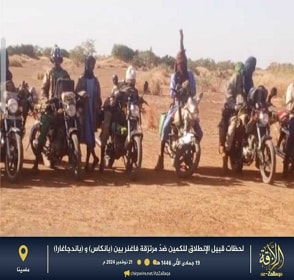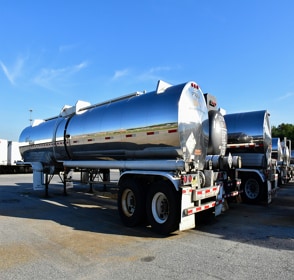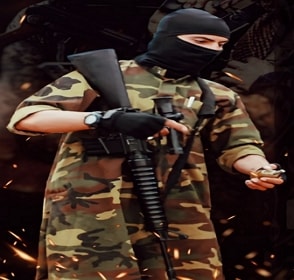The following report is now a complimentary offering from MEMRI's Jihad and Terrorism Threat Monitor (JTTM). For JTTM subscription information, click here.
On October 29, 2023, the London-based Saudi weekly Al-Majalla published[1] an Arabic-language article titled "Iran's Militias In Syria: Names, Numbers, Deployment," which was released in an English version on November 4 as "A Complete Guide to Iranian-Backed Militias in Syria."[2] The lengthy article contains information about Iran-backed militias in Syria, which "could be activated on any second front in the war between Hamas and Israel," including a list of groups detailed by name, number of forces and areas of activity, after a claimed repositioning following the ongoing war between Israel and Hamas.
According to the article, Iran-backed militias in Syria have intensified their presence in the Syrian Golan region since the beginning of the Israel-Hamas war, threatening to activate the front— inactive since the 1974 Agreement on Disengagement between Israel and Syria—if Israel continues its military action Gaza. The article mentions that the "messages" of Iran from the Golan have so far been limited to skirmishes consisting of firing mortars from Syrian territory.
Al-Majalla asserts that the deployment of Iran-backed militias in Syria began in May 2011, a month and a half after the outbreak of protests against the Syrian regime. It quotes a February 2022 report[3] by the Syrian Observatory for Human Rights (SOHR), according to which the militias include at least 65,000 forces from various countries, including Syria, Iraq, Lebanon, Afghanistan, and Pakistan, distributed in areas controlled by the Syrian regime. Hossein Salami, the commander of Iran's Islamic Revolutionary Guard Corps (IRGC), claimed in August 2020 that there were more than 100,000 forces in Syria, belonging to 70 militias.
According to an SOHR report[4] from December 2021, the number of Iran-backed militia forces in southern Syria, including the governorates of Daraa, Quneitra, and Al-Suwayda', was estimated at 11,500. The recruitment processes were conducted by "Saraya Al-'Arin" (the Den Companies) affiliated with the Iran-backed "313th Brigade," which has centers in northern Daraa; the Lajat region on the outskirts of Daraa; the town of Khan Arnabah and the city of Madinat Al-Baath in the Quneitra governorate; and on the outskirts of Al-Suwayda'.
In May 2020, the IranWire website reported that following the Syrian regime's overtaking of southern Syria in the summer of 2018, Iran formed 16 "local fighting groups," designating them as "Syrian Hizbullah." The article adds that according to its information, non-Syrian militias, including fighters from Hizbullah and a range of foreign nationals, have deployed in the region for the first time since the Syrian civil war.
Iran-Backed Groups Belonging To Syrian Hizbullah In Daraa
Based on the IranWire report, Al-Majalla lists prominent Iran-backed groups subsumed under the umbrella of Syrian Hizbullah in the Daraa governorate.
Saraya Al-'Arin. A military formation consisting of Daraa residents. With its main headquarters located in the Al-Kashif neighborhood in Daraa, it consists of 600 members, under the command of Waseem Masalmah. Its missions include fighting alongside the Syrian Army in the Daraa governorate. Funded by Iran.
The Dir' Al-Watan [Shield of the Homeland] Brigade. Consisting of nearly 400 members, the group is commanded by Tariq Ma'rouf. Centered in Daraa. Its membership increased following the Syrian regime's regaining of control over southern Syria.
The Khaled Al-Hashish Group. This group was formed of members of Syrian rebel groups which reconciled with the regime. It is commanded by Khaled Al-Hashish, who is close to the Syrian Army's 4th Division, commanded by Maher Al-Assad, brother of Syrian President Bashar Al-Assad. The group's main headquarters are located in the village of Tell Shihab, in the west of the Daraa governorate. The group's members are deployed near the border with Jordan, in the villages of Tell Shihab, Al-Tabariyat, and Zayzun.
The Abu Salem Group. Consisting of 300 members, the group is commanded by Ahmad Mahawish a.k.a. "Abu Salem Al-Khalidi." Its main center is in the village of Kharab Al-Shahm, northwest of Daraa, near the border with Jordan. The group also has centers in the villages of Al-'Ajami (Daraa governorate), Nab' Al-Fawwar (Quneitra governorate), Khirbet Qeis (Daraa governorate), and Nahj (Daraa governorate). The group's members are involved in drug smuggling to Jordan.
The Haytham Abu Su'ayfan Group. The group consists of nearly 200 members under the command of Haytham Abu Su'ayfan, a retired member of the Syrian Military Intelligence Directorate, currently working for Hizbullah. The group's members are deployed in the town of Al-Shajarah and the surrounding villages in the Al-Yarmouk basin area, bordering the Israel-controlled Golan Heights in the west, and Jordan in the south.
The Majd Al-Malohi Group. The group's headquarters are located in the Lajat region on the northeastern outskirts of Daraa. The group is affiliated with Hizbullah, and most of its members previously belonged to the Al-Omari Brigades, a Syrian rebel group which reconciled with the regime. It consists of approximately 200 members involved in drug smuggling.
The Samer Al-Hariri Group. 200 members, former members of the Amoud Hauran [Pillar of Hauran] Brigade, a Syrian rebel group which reconciled with the regime. The group is commanded by Samer Al-Hariri, a former commander in the Free Syrian Army (FSA). Its center is based in the town of Busra al-Harir on the eastern outskirts of Daraa.
The Muhammad Al-Haraki Group. The group consists of nearly 100 members under the command of Muhammad Al-Haraki, most of which are former members of "reconciliation" factions. The group's headquarters are located in the town of Al-Mulayhah, on the eastern outskirts of Daraa.
The Fares Al-Hawilah Group. Nearly 100 members of former "reconciliation" factions, commanded by Fares Al-Hawilah. The group is centered in the village of Ghasm, northeast of Daraa.
The 'Ali Al-'Adhabah Group. Commanded by 'Ali Al-'Adhabah, the group's members are from the town of Busra Al-Sham, on the eastern outskirts of Daraa.
Iran-Backed Groups Belonging To Syrian Hizbullah In Quneitra
There are also several Iran-backed groups belonging to Syrian Hizbullah in the Quneitra governorate.
The Khader Hlehel Group. Consisting of former members of the "Al-Sibteen Brigade" rebel group which reconciled with the regime, the group is based in the village of Al-Rafid, in the center of the Quneitra governorate.
The Ahmad Kabul Group. The group consists of supporters of the regime. Its center is in the town of Khan Arnabah, on the northern outskirts of Quneitra.
The Mu'adh Nassar Group. The group consists of former members of "reconciliation" factions from the town of Jubata Al-Khashab and its surroundings.
The Abu Ghadir Group. A former opposition rebel group which reconciled with the regime. Located in the village of Ghadir Al-Bustan, on the southern outskirts of Quneitra.
The Zaher Al-Hamed Group. A former opposition rebel group which reconciled with the regime. Located in the village of Sayda.
Based on IranWire, Al-Majalla asserts that Iran-backed militias control several strategic hills in southern Syria, including Tall Mar'i, Tulul Fatima, Tall Ayub, Tall Qarin, Tall Al-Harrah, Tall Al-Jabiyah, Tall Al-Jumu', Al-Tulul Al-Humur, and Tall Al-Za'tar. The militias take advantage of these positions for "advanced surveillance," while using vehicles and uniforms of the Syrian Army. The Syrian Army's 4th Division and other Iran-backed forces use Syrian Army headquarters as temporary operations centers, changing them from time to time, in an attempt to avoid a possible targeting by the U.S.-led Global Coalition against ISIS or Israel.
In Quneitra, the Golan Regiment militia is deployed, headed by Khaled Abaza, secretary of the Baath party branch in the governorate. The forces include five brigades and one company, totaling more than 325 militants. The militia is strongly tied to Lebanese Hizbullah: several of its members have taken military courses at Hizbullah camps in Lebanon, and it receives financial, logistical, and military support from Hizbullah directly.
In mid-2022, IranWire published a map showing locations of Iranian forces and affiliated militias in southern, central, and northern Syria, in addition to sites where the militias commonly carry out drug manufacturing and smuggling activities. According to the map, Iranian forces and affiliated militias controlled 28 locations in southern Syria. IranWire further reported that the 313th Brigade, a Shi'ite group affiliated with the IRGC and commanded by Ibrahim Marji, was based in the town of Izra', north of Daraa, and consisted of 1,200 fighters. According to the report, its mission was to protect strategic weapons depots in southern Syria.
The Al-Majalla article quotes "sources from southern Syria" stating that Iranian forces and Iran-backed militias increased their presence in southern Syria following the February 2022 Russian invasion of Ukraine, and suggesting that this might have been done "in coordination with Russia, or at least with its understanding," possibly in response to Israel not fully siding with Russia in the conflict.
Iranian Forces Deploy Along Border With Israel Following Israel-Hamas War
As soon as the Israel-Hamas war broke out on October 7, news began to appear of a large mobilization carried out by Iranian forces and affiliated militias along the Golan border. The article quotes "several sources in the region" asserting: "We had been aware of their presence, but the scale of their deployment along the front line was unprecedented."
Based on a report[5] by the Syrian news website Damascus Voice, Al-Majalla states that according to "security sources," forces of Hizbullah's elite Radwan unit arrived in Syria within 24 hours of the October 7 attack, deploying along the border. The website also reported that according to its sources, an officer in Iran's IRGC known as Muhammad Assad Allah moved from the town of Al-Sayyidah Zaynab, south of Damascus, to the Golan region, accompanied by IRGC forces. The sources claimed that the officer and his troops oversaw the transfer of drones from the IRGC headquarters in the Daraa governorate to military positions near the Golan.
In addition, on October 10 Damascus Voice reported[6] that according to "special sources," groups affiliated with Hizbullah arrived from Hizbullah bases in Lebanon and Syria to a youth hostel near the village of Bariqah in the Quneitra governorate, deploying about two kilometers from the "Golan front." At the same time, the Golan Regiment militia was ordered to raise alertness, summon all its members, and cease any military activity not related to the orders. The sources mentioned that the Golan Regiment militia is deployed in Madinat Al-Baath, Khan Arnabah, and Jabah, as well as in most of the villages near the border, where it also has "local groups affiliated with it."
Non-Arab Iran-Backed Shi'ite Militias In Syria
According to the 2020 IranWire report, several non-Arab Iran-backed military formations are present in Syria, in addition to the Iranian IRGC and its Quds Force, whose number in Syria is estimated at 8,000 forces deployed in the governorates of Rif Dimashq, Tartus, and Latakia. The article mentions the following:
Fatemiyoun Brigade. Made up of Hazara (a mostly Shi'ite ethnic group from Afghanistan) who have fled to Iran, the group was formed in 2014 under the command of Ali Reza Tavassoli, killed in Daraa in 2015. The group consists of about 3,000 members, deployed in the Al-Sayyidah Zaynab region, south of Damascus.
Zainebiyoun Brigade. A group of Pakistani fighters, mostly Pashtuns (an ethnic group in Pakistan and Afghanistan). The group was established by Muhammad Jannati, known as Hajj Haydar, a Pakistani fighter who was killed in Hama, Syria, fighting rebel factions. Numbering nearly 1,000, the group's fighters are deployed in Damascus and its environs under the pretext of protecting the Al-Sayyidah Zaynab Mosque. They participated in the battles in Aleppo, Daraa and Hama alongside the Syrian Army. Zainebiyoun Brigade split off from Fatemiyoun Brigade. The group's members are trained in Iran, before being sent to Syria.

Fighters from the Fatemiyoun Brigade, Syria.
Iran-Backed Iraqi, Palestinian Armed Groups In Syria
In addition, several Arab Iran-backed militias maintain a presence in Syria.
Lebanese Hizbullah. The group avoids establishing permanent positions in Syria, instead employing special units within the Syrian Army to carry out its operations and activity. It uses civilian houses in the Al-Sayyidah Zaynab region, south of Damascus, as temporary headquarters, changing them from time to time. The group's members operate in the Al-Sayyidah Ruqayyah Mosque in the Old City of Damascus, especially in the Al-Shaghur neighborhood, which has a Shi'ite majority. In addition, the group is present in the city of Al-Qusayr, on the western outskirts of Homs, whose residents left following the battles against opposition factions. Hizbullah influences and controls most of the Shi'ite formations in Syria, although it is resented by many Syrian militias, who view the Syrian Army as showing favoritism to Lebanese fighters over Syrians.
The Abu Al-Fadl Al-'Abbas Brigade. A group of Iraqi fighters commanded by Maher 'Ajib Jazah a.k.a. Abu 'Ajib, from the town of Nubl near Aleppo. The group's size is unstable due to frequent defections.
Iraq's Kata'ib Hizbullah (Hizbullah Brigades) sent nearly 7,000 forces to Syria in 2013, under the command of Hashem Al-Hamdani (Abu Ala'). The Al-Nujaba Movement, Zulfiqar Brigade, and Asa'ib Ahl Al-Haq have also fought alongside the Syrian Army. Asa'ib Ahl Al-Haq has headquarters in Rif Dimashq and Al-Bukamal.
Faylaq Al-Wa'd Al-Sadeq (The True Promise Corps). An Iraqi militia headed by Muhammad Hamzah Al-Tamimi a.k.a. Abu 'Ali Al-Najafi, with nearly 2,000 members distributed across Iraq and Syria. The group has a sub-headquarters in Rif Dimashq, and its combat activity is focused on Damascus and Aleppo. The group also includes Syrian members from the Idlib governorate.
Saraya Tala'i' Al-Khorasani (Khorasani Vanguards Companies). An Iraqi formation established in 1984, with about 5,000 fighters in Iraq and Syria. Its missions include protecting the Damascus International Airport. Its Syrian offices are located in the Rif Dimashq and Aleppo governorates.
The Martyr Muhammad Baqir Al-Sadr Forces. An Iraqi formation missioned with reinforcing the Syrian General Intelligence Directorate and Ministry of Interior. The group's members wear the uniforms of the Syrian police.
The Imam Husayn Brigade. An Iraqi group deployed in Rif Dimashq and Aleppo. Commanded by Amjad Al-Bahadli.
Several other small Iraqi groups in Syria are mentioned by name: The 'Ammar Bin Yasser Brigade, the Assad Allah Al-Ghalib Brigade, Saraya 'Ashura', Jaysh Al-Mu'ammal, the Al-Yawm Al-Maw'ud Brigade, the Baqiyat Allah Brigade, and the Al-Tadakhul Al-Sari' [Rapid Intervention] Regiment.
The Al-Quds Al-Filastini Brigade. A military group of Palestinians from the Bab Al-Nayrab refugee camp in Aleppo. The group was founded by Eng. Muhammad Al-Sa'id in 2013 with the support of Iran. Its members participated in several battles in Aleppo, Damascus, Deir Al-Zour, and Daraa. The group's size is estimated at 2,500-3,000 fighters. Its main headquarters are based in the Bab Al-Nayrab camp. The group has training camps in the Handarat camp, Sheikh Najjar and Al-Mallah, near Aleppo.
The Popular Front for the Liberation of Palestine (PFLP) – General Command. Based in Damascus and supported by Iran, the members of this veteran Palestinian group fought in the Al-Yarmouk camp and southern Rif Dimashq alongside the Syrian Army. The group is strongly tied to Hizbullah, and its members train in bases in Lebanon. It also has training camps in the Syrian city of Saydnaya, north of Damascus, and in Al-Sabbourah, in western Rif Dimashq.
Pro-Regime Syrian Militias
There are also several militias comprised of native Syrians – Shi'ites, Sunnis, Druze, Alawites, and other sects – funded by Iran and Syrian businessmen, serving as auxiliary forces alongside the Syrian army. Some of these militias are involved in drug trafficking and oil smuggling between the regime and the Islamic State (ISIS), or between the regime and the Syrian Democratic Forces (SDF).
The Al-Qatarji Militia. Founded by businessman Husam Ahmad Qatarji, the group recruited fighters from Deir Al-Zour to fight alongside the Syrian Army in the battles in Deir Al-Zour, Aleppo, and Idlib. The group funds itself by means of oil smuggling between SDF and the Syrian regime through the Al-Qatarji company, which owns more than 400 vehicles for oil transportation.
The National Defense Forces (NDF). Military formations concentrated in the provincial centers. Headed by Fadi Ahmad, they are supported by the Syrian Army and directly affiliated with the IRGC's Quds Force, participating in its military operations. The size of these formations differs in each governorate. In 2013, the NDF reportedly consisted of 100,000 members.
The Al-Nimr (Tiger) Forces. Nearly 8,000 fighters under the command of Suhayl Al-Nimr. These Syrian ground forces are loyal to Iran, which has given them substantial military support. The forces helped the regime regain control over several regions in Syria with the support of Russian aircraft.

Syrian soldiers and pro-regime militiamen in Deir Al-Zour.
The Al-Zahra' Brigade. A military group of residents of the town of Al-Zahra' in the Aleppo governorate.
The Al-'Abbas Brigade. Nearly 200 fighters from Kafraya and Al-Fu'ah in the Idlib governorate.
The Shahid Al-Mihrab Brigade. A military group from the town of Nubl, northwest of Aleppo, consisting of nearly 150 fighters. The above three militias are supported by Iran and fight alongside the Syrian Army.
Data presented by the Jusoor research institute in collaboration with the InformaGENE blog showed that as of mid-2023, 830 foreign military bases and positions were present in Syria, distributed across all Syrian governorates. Of these, Iran has the most – 570 – followed by Turkey with 125, Russia with 105, and the U.S.-led International Coalition with 30.

The above map shows the locations of 515 military positions and 55 military bases of the Iran-backed militias in regime-controlled parts of Syria. Red circles indicate IRGC posts, blue circles Lebanese Hizbullah posts, and red and blue circles joint positions.
Since the outbreak of the ongoing Israel-Hamas war, MEMRI JTTM has surveyed multiple reports from the Syrian and Arab press according to which Iran-backed militias have increased their presence in Syria, particularly near the border with Israel, as well as along the Iraqi border.[7] Over the past two weeks, almost daily rocket and drone attacks on U.S. bases in eastern Syria have been claimed by the Iran-backed "Islamic Resistance in Iraq," although Syrian opposition websites have alleged that some of these attacks were ordered and carried out by Iran-backed militias located in Syria.[8]
[1] October 29, 2023.
[2] November 4, 2023.
[3] February 19, 2022.
[4] December 29, 2021.
[5] October 8, 2023.
[6] October 10, 2023.
[7] See MEMRI JTTM reports: Arab And Syrian Opposition-Affiliated Media Outlets: Hizbullah, Iranian Islamic Revolutionary Guard Corps (IRGC), Additional Iran-Backed Militias In Syria, All Bolstering Forces In Southern Syria In Event That Fighting Between Israel And Palestinian Factions Spreads To Syrian Arena, October 10, 2023; Syrian Opposition Website: Elite Forces From Iran-Backed Militias Deploy Along Syrian Border With Israel On Golan Heights Under Hizbullah Supervision, With No Coordination With Syrian Regime, October 23, 2023; Syrian Opposition Websites: Iran-Backed Militias Enhance, Entrench Presence Along Syria's Borders With Iraq, Israel, October 26, 2023; Iraqi Popular Mobilization Units (PMU) Secretly Sends Weapons, Dozens Of Operatives To Syria; Some Near The Border With Israel, November 5, 2023; and Arab Media Reports: Iran-Backed Militias Intensify Presence In Southern Syria, Recruit New Members To Participate In Fighting Against Israel, November 6, 2023.
[8] See MEMRI JTTM reports: Syrian Opposition Website: Attacks On International Coalition Bases in Syria Carried Out By Iran-Backed Iraqi Militias, Hizbullah Brigades, Asa’ib Ahl Al-Haqq, Sleeper Cells Of Iranian Militias And Other Local Militias, At Order Of IRGC Qods Force Commander Qaani, October 30, 2023; and Syrian Opposition Websites: Senior IRGC, Hizbullah Officials Involved In Directing Attacks By Iran-Backed Militias On Bases Of U.S. Forces, Global Coalition, In Northeast Syria, November 2, 2023.
The full text of this post is available to subscribers.
Please login or register to request subscription information from MEMRI









